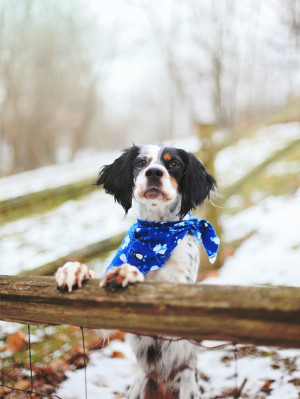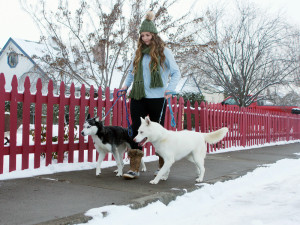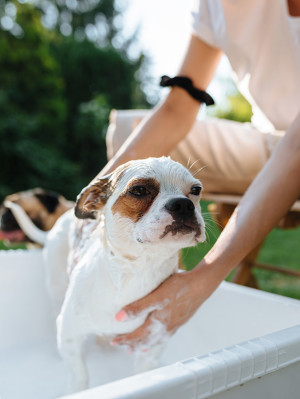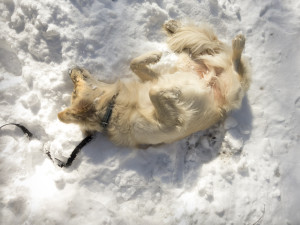Common Symptoms of Hyperkeratosis in Dogs
Look out for these issues.
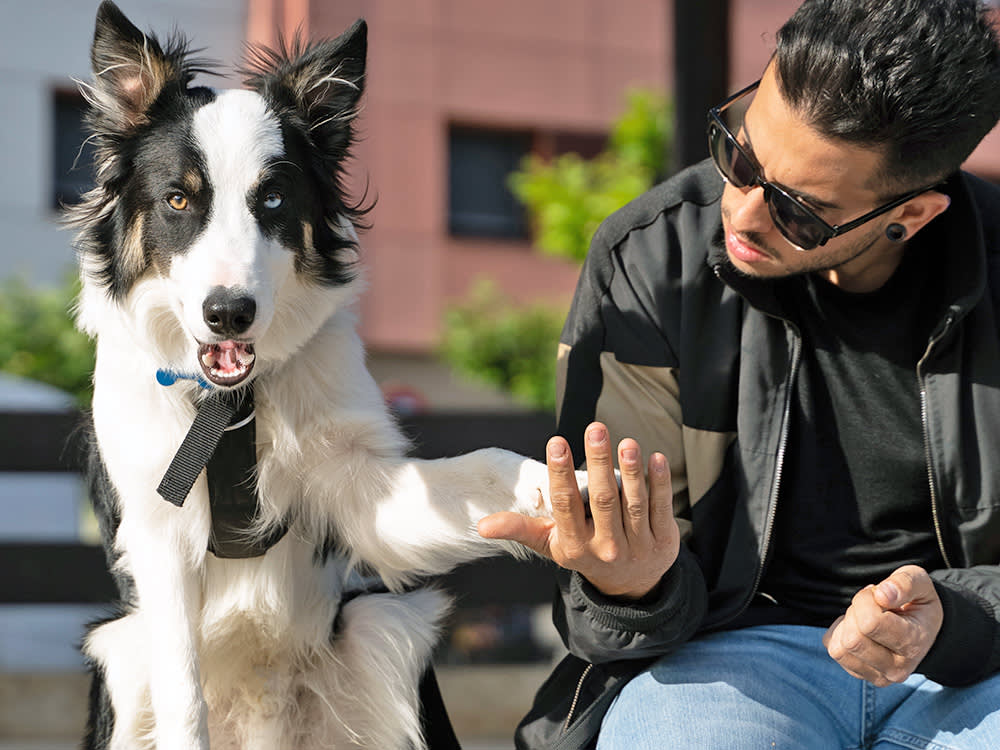
Share Article
In This Article:
What Is Hyperkeratosis in Dogs? Common Symptoms of Hyperkeratosis in Dogs What Causes Hyperkeratosis in Dogs? How to Treat Hyperkeratosis in Dogs How to Prevent Hyperkeratosis in Dogs
Have you noticed that your dog’s paws or nose seem rough, dry, or cracked? You might be seeing evidence of hyperkeratosis. While hyperkeratosis may sound a little scary, understanding its signs and knowing what can cause it can help you take action before it gets worse.
Let’s dive into the common signs you might spot and what they could mean for your pup.

What is hyperkeratosis in dogs?
Hyperkeratosis in dogs is a condition in which the skin becomes thickened and rough. It’s seen most commonly o n the nose and paw pads but can also be found on other areas of the body, especially over pressure points. The thickened skin may develop pain cracks and fissures, which can lead to pain and infection. Hyperkeratosis is generally a symptom of another problem, not a disease by itself.
Hyperkeratosis occurs in the outer layer of skin. Healthy skin maintains a consistent thickness by producing skin cells at about the same rate that they are shed. Problems with increased production of skin cells, failure of skin cells to shed, or abnormalities in maturation of skin cells can all lead to a dog’s skin thickening.
Common symptoms of hyperkeratosis in dogs
Hyperkeratosis is easy to notice when it’s on an area of your dog you see all the time, like their nose. Symptoms of hyperkeratosis in dogs are less obvious when they’re in areas you may not pay as much attention to like your dog’s elbows or abdomen, especially in long-haired breeds.
These are some of the telltale signs to keep an eye out for:
Dry or cracked nose
Skin discoloration
Crusty ear margins
Elbow or hip calluses
Bumps or growths
Pain when walking
What causes hyperkeratosis in dogs?
Because hyperkeratosis is usually a symptom of another problem, it doesn’t always have a single cause. Many conditions in dogs can result in thickening of the skin, including:
Viral diseases: One of the classic causes of hyperkeratosis is canine distemper, which is also known as “hardpad disease” because of the changes to the footpads of infected dogs. Canine papillomavirus infections can also cause hyperkeratosis, and the lesions are not always limited to the nose and paw pads.
Genetic conditions: Hyperkeratosis occurs more commonly in some dog breeds. A genetic form of hyperkeratosis related to abnormal zinc metabolism is recognized in Boston Terriers and Arctic dog breeds like the Siberian Husky, Alaskan Malamute, and Samoyed.
Age-related changes: It’s not uncommon for older dogs to develop areas of thickened skin. This may be related to gradual dysfunction of the cells that produce the outer layer of skin or chronic wear and tear. With age, the overgrowth of skin on the nose and paw pads may be more frond-like, with thinner projections around the edges of affected areas.
Allergies: Environmental or dietary allergies are common causes for chronic skin irritation in dogs. Repeated cycles of skin inflammation, infection, and trauma can leave dogs with thickened skin due to hyperkeratosis. This can occur anywhere on the body but is most commonly seen on the ears, lower abdomen, and tail.
Dietary deficiencies: Hyperkeratosis due to zinc deficiency was more common before the modern guidelines for the nutritional composition of dog diets were developed. This is why it’s important to consult with a veterinary nutritionist if you’re thinking about feeding your dog a homemade diet: getting the balance of micronutrients like zinc right is a challenge.
Environmental factors: Does your dog love to stretch out on rough concrete instead of the plush dog bed you bought for them? Some dogs just love a hard surface, but it can be rough on their body. Hyperkeratosis can develop due to chronic pressure over bony points like the elbows, knees, and hips. Large-breed dogs are more likely to develop problems due to this.
How to treat hyperkeratosis in dogs
Before treating hyperkeratosis, your veterinarian may recommend testing to find out if there’s a cause and rule out some other conditions that can produce similar symptoms. Depending on your dog’s age and vaccination status, this can involve testing for viral infections and biopsy of an affected area. Samples may also reveal the presence of bacterial or fungal infections that can develop when the skin has openings due to fissures.
Once your vet has assessed your dog, they’ll be able to recommend treatment that’s appropriate for your dog’s condition. The goal of treatment for hyperkeratosis in dogs is to soften and eventually remove excess skin. This can take some persistence on the part of pet parents. Hyperkeratosis doesn’t resolve in just a few days; it may take a couple of months to see significant improvement. Some common treatments include:
Moisturization
As my wife likes to remind me, moisturization is the key to healthy skin. A veterinary balm made specifically for dogs with hyperkeratinization of their nose and paw pads has been shown to improve skin lesions. Other topical therapies that your vet may recommend include petroleum jelly, salicylic acid, and propylene glycol. Always check with your vet before starting any of these products to make sure you’re using a product and concentration appropriate for dogs.
Gentle scrubbing
Once softened, excess skin may wear off over time. Your vet may advise some gentle scrubbing after foot soaks, but this may not be necessary. It can cause some dogs discomfort and could lead to open wounds if you’re not careful. In cases of severe hyperkeratosis, a veterinary dermatologist may remove hyperkeratotic skin under sedation.
Veterinary medications
Medications like antibiotics or antifungals may be needed for dogs with secondary infections due to wounds from hyperkeratosis. Mild infections may only require topical therapy, sometimes combining topical antibiotics and antifungals with a localized steroid to help reduce inflammation. Pain control medication may be needed in dogs with lesions that are affecting their ability to eat or walk comfortably.
How to prevent hyperkeratosis in dogs
While you can’t always prevent hyperkeratosis in dogs, there are things you can do to minimize the risk and help manage the condition effectively. Some ways to limit your dog’s risk of hyperkeratosis include:
Routine skin care
Staying on top of your dog’s skin health is important. Work with your vet to keep any environmental or dietary allergies under control to help prevent inflammation and skin infections. Keep your dog on monthly flea and tick control to keep those nasty critters at bay. Only use shampoos made for dogs when bathing. For long-haired dogs, regular brushing and trips to the groomer are a must to prevent skin issues.
Protective gear
Dogs with pressure sores and hyperkeratosis may benefit from booties or specialized orthotics to give their joints some relief. But protective gear doesn’t have to be fancy: It can be as simple as providing comfortable bedding in your dog’s favorite relaxation spots. Some dogs prefer an elevated bed (kind of like a cot) instead of a pillowy one. Try different options to see what your dog likes.
Healthy diet
Making sure your dog is on a good-quality commercial diet that meets AAFCO feeding standards is important for their overall health. Because some causes of hyperkeratosis are linked to zinc deficiency, be sure to have your vet double check your dog’s diet composition if they’re having issues with hyperkeratosis.
Knowing when to seek professional help
It’s important to know when it’s time to consult your vet about hyperkeratosis. It’s important to get a skin health consultation if you suspect your dog has hyperkeratosis, but schedule an appointment as soon as possible if you notice any of these signs:
Pain
Open wounds
Discharge
Swelling
Limping
Bottom line
Hyperkeratosis in dogs is characterized by thickened skin, especially on the paws, nose, or elbows. It's often due to genetic factors, age, or underlying health conditions. If your dog’s skin is getting thicker or developing cracks, it’s time to check in with your vet for a proper diagnosis and treatment plan.
References
Areco, Walter V C et al. “Macroscopic Distribution, Histopathology and Viral Antigen Expression in Dogs with Canine Distemper Virus-induced Hyperkeratosis in Nasodigital and Other Regionsopens in new tab.” Journal of Comparative Pathology vol. 193 (2022): 9-19. doi:10.1016/j.jcpa.2022.02.002.
Catarino, Mathilde et al. “Control of canine idiopathic nasal hyperkeratosis with a natural skin restorative balm: a randomized double-blind placebo-controlled study.opens in new tab” Veterinary Dermatology vol. 29,2 (2018): 134-e53. doi:10.1111/vde.12506.
Cikota, Robert et al. “Nasal hyperkeratosis in Griffon breeds: Clinical, histopathological features and the prevalence in the Swedish population compared to a control group and other brachycephalic breedsopens in new tab.” Veterinary Record Open vol. 8,1 e10. 5 May. 2021, doi:10.1002/vro2.10.
Lee, Fiona F et al. “Localized parakeratotic hyperkeratosis in sixteen Boston terrier dogsopens in new tab.” Veterinary Dermatology vol. 27,5 (2016): 384-e96. doi:10.1111/vde.12369.
Munday, John S et al. “Papillomaviral skin diseases of humans, dogs, cats and horses: A comparative review. Part 1: Papillomavirus biology and hyperplastic lesionsopens in new tab.” Veterinary Journal (London, England : 1997) vol. 288 (2022): 105897. doi:10.1016/j.tvjl.2022.105897.

Dr. Bartley Harrison, DVM
Dr. Bartley Harrison is a veterinarian with more than 19 years of experience. He has treated a variety of species in emergency and speciality practices for both large and small animals. His primary interests as a vet are emergency medicine and critical care.
Related articles
![a Chihuahua dog licking their paw]()
Why Do Dogs Lick Their Paws?
Their toes might smell like Fritos, but there’s no way they taste that good.
![Brunette girl kisses the paw of a corgi dog.]()
Dry Paws on Dogs: Causes, Symptoms, and Treatment
You call them toe beans. Your vet uses more technical terms. Whatever they’re called, take care of them.
![Young woman takes husky dogs for a winter walk.]()
How to Keep Your Dog’s Paws Safe From Snow Salt
Tips for safe, snug, and happy paws this winter.
Why Does My Dog Bite Their Nails?
Is that an OK habit for them to have?
![Little dog getting showered by his owner in the backyard.]()
How to Treat Dog Skin Diseases at Home
And how you might safely give your pup immediate relief.
![Winterizing your dog's coat - Dog laying in the snow.]()
Natural Remedies for Dry Skin: How to Help Dry Skin on Dogs
Spoiler: These at-home remedies are probably already in your pantry.

